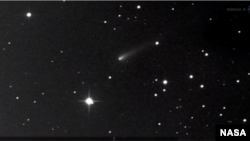Comet ISON was spotted and photographed by amateur astronomers as the highly- anticipated arrival of the icy space visitor nears.
"I photographed Comet ISON on September 15 using my 4-inch refractor," reports astrophotographer Pete Lawrence of Selsey in the United Kingdom. "The comet's tail is nicely on view even through this relatively small instrument."
In Aquadilla, Puerto Rico, astronomer Efrain Morales Rivera saw the comet on September 14 "rising above the canopy of the rain forest just minutes before sunrise. I used a 12-inch telescope," he said.
ISON, which will make its closest approach to the sun on November 28, has the potential to be a spectacular sight, depending on how it reacts to the solar heating it will receive.
NASA, the U.S. space agency, said that in mid-September the approaching comet was glowing like a star of 14th magnitude. That's dimmer than some forecasters expected.
"Certainly we would love it to be a couple of magnitudes brighter right now," said researcher Karl Battams of the Naval Research Lab in Washington, D.C., "but it's doing just fine. I'd say it's still on course to become a very eye-catching object."
NASA cautions that comets are capable of “fizzling at the last minute even after months of promising activity.”
However, if ISON survives its brush with solar fire, it could be visible to the naked eye, NASA said.
Based on the latest images, internationally known comet expert John Bortle said "ISON appears likely to survive the inbound leg of its journey all the way to the Sun. It will probably brighten more slowly than all the early hype led the public to believe. Nevertheless, Comet ISON should very briefly become exceptionally bright, at least rivaling the planet Venus in the hours preceding its closest approach to the sun."
After November 28, ISON will emerge from the sun's glare well-positioned for observers in the northern hemisphere. The comet's tail will likely be visible to the naked-eye in both the morning and evening sky throughout December 2013.
The last comet that did this sort of thing was Comet Lovejoy, which gave viewers in the southern hemisphere a view of the comet’s tail stretching halfway across the sky.
Here's a video about ISON:
"I photographed Comet ISON on September 15 using my 4-inch refractor," reports astrophotographer Pete Lawrence of Selsey in the United Kingdom. "The comet's tail is nicely on view even through this relatively small instrument."
In Aquadilla, Puerto Rico, astronomer Efrain Morales Rivera saw the comet on September 14 "rising above the canopy of the rain forest just minutes before sunrise. I used a 12-inch telescope," he said.
ISON, which will make its closest approach to the sun on November 28, has the potential to be a spectacular sight, depending on how it reacts to the solar heating it will receive.
NASA, the U.S. space agency, said that in mid-September the approaching comet was glowing like a star of 14th magnitude. That's dimmer than some forecasters expected.
"Certainly we would love it to be a couple of magnitudes brighter right now," said researcher Karl Battams of the Naval Research Lab in Washington, D.C., "but it's doing just fine. I'd say it's still on course to become a very eye-catching object."
NASA cautions that comets are capable of “fizzling at the last minute even after months of promising activity.”
However, if ISON survives its brush with solar fire, it could be visible to the naked eye, NASA said.
Based on the latest images, internationally known comet expert John Bortle said "ISON appears likely to survive the inbound leg of its journey all the way to the Sun. It will probably brighten more slowly than all the early hype led the public to believe. Nevertheless, Comet ISON should very briefly become exceptionally bright, at least rivaling the planet Venus in the hours preceding its closest approach to the sun."
After November 28, ISON will emerge from the sun's glare well-positioned for observers in the northern hemisphere. The comet's tail will likely be visible to the naked-eye in both the morning and evening sky throughout December 2013.
The last comet that did this sort of thing was Comet Lovejoy, which gave viewers in the southern hemisphere a view of the comet’s tail stretching halfway across the sky.
Here's a video about ISON:









